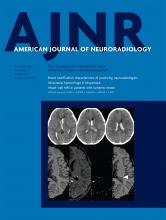In this issue, Liu et al1 found that choroidal collateral anastomosis was a predictor of the recurrent hemorrhage of Moyamoya disease (MMD), especially lateral posterior choroidal artery anastomosis. This study will further deepen our understanding of the risk factors of MMD rebleeding.
The predominant feature of the pathology of MMD is now known to be progressive stenosis of the carotid artery terminations and the development of dilated, fragile perforating arteries, which are termed “Moyamoya vessels.” Although MMD is an uncommon cerebrovascular disease, it is an important cause of stroke. Most pediatric patients have ischemic attacks, whereas adult patients can have ischemic attacks, bleeding attacks, or both. More than half of adult MMD presents with intracranial bleeding. Such bleeding attacks are potentially fatal and seriously affect the patients' prognoses. The common hemorrhage site of MMD is intraventricular hemorrhage, and it is also common in the paraventricular area of the posterior lateral ventricle (ie, the blood supply area of the lateral posterior choroidal artery). A previous case-control study found that the compensatory dilated anterior choroidal artery and posterior communicating–posterior cerebral artery were associated with bleeding manifestations of MMD, but not with recurrent bleeding of MMD.2
Pseudoaneurysms are often found in children's MMD by digital subtraction angiography after bleeding. Most of the aneurysms are located in the posterior choroidal artery. Encephalo-duro-arterio-synangiosis is often effective for these patients.3,4 In other locations, if the aneurysm is accessible endovascularly, coils or Onyx (Covidien, Irvine, California) embolization is also an effective treatment.5 The proliferation of dural vessels in the cavernous sinus can lead to a dural arteriovenous fistula, which tends to spontaneous occlusion.6 A recent study by Cho et al7 found that the risk of stroke was 4.5% per year in 241 cases of MMD. Intraventricular hemorrhage was associated with recurrent hemorrhage of MMD, and the risk of recurrent hemorrhage in hemorrhagic MMD was 4.3%. The risk of recurrent ischemic stroke in ischemic presentations was 3.0%; the risk of stroke in asymptomatic MMD was no less than in the former 2 groups. Thyroid disease and family history are both risk factors for stroke. A survey of 128 patients with conservatively managed hemorrhagic MMD provided a rebleeding rate of 4.5% per year.8 The cumulative risk of rebleeding was 7.8% at 5 years, 22.6% at 10 years, and 35.9% at 15 years. The morbidity and mortality after rebleeding was 44.7%. Funaki et al9 investigated 75 hemorrhagic hemispheres of 75 patients and found that choroidal anastomosis and posterior cerebral artery involvement were factors associated with posterior hemorrhage. They concluded that choroidal anastomosis might be considered a potential source of posterior hemorrhage at high risk of rebleeding.
There are 2 main causes of intracranial bleeding in MMD: rupture of dilated, fragile Moyamoya vessels (perforating arteries) and rupture of circle of Willis aneurysms. Another rare cause of bleeding in adult patients is rupture of the dilated collateral arteries on the brain surface. In this study,1 the authors report that bleeding or posterior ventricle bleeding is caused by the Moyamoya vessels rupture. The choroidal arteries play an important role in providing collateral circulation in MMD, especially the lateral posterior choroidal artery. Although the authors found that lateral posterior choroidal artery anastomosis was a predictor of rebleeding of MMD, there was selection bias in this study because 43% of patients had been excluded.
References
- © 2019 by American Journal of Neuroradiology












